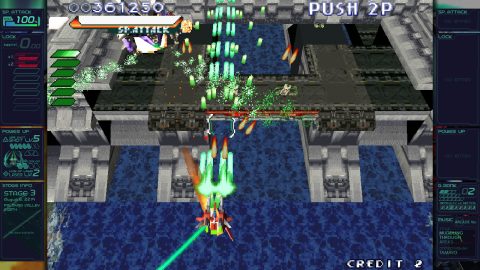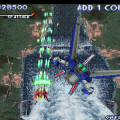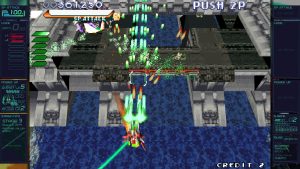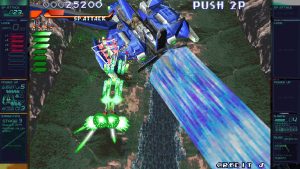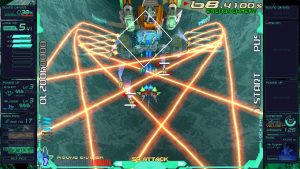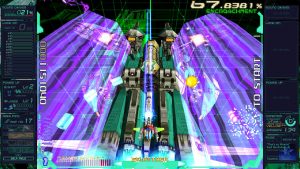- RayForce
- RayStorm
- RayCrisis: Series Termination
- Ray’z Arcade Chronology
After re-releasing the Darius games as the Darius Cozmic Collection and G-Darius / G-Darius HD, M2 has returned to Taito’s other big shoot-em-up series with the Ray’z Arcade Chronology. The “Ray’z” name seems to be Taito’s official designation for the 90s-era trilogy consisting of RayForce, RayForce, and RayCrisis, which all feature the same incredibly satisfying lock-on laser game mechanics as well as the usual spacey soundtracks from inhouse band Zuntata. This collection offers ports of all three games, based on the original arcade versions, developed by M2 as part of their ShotTriggers line of shoot-em-ups. Beyond their incredible emulation accuracy, they also include gadgets on the side of the screen, which let you know your current stage, the difficulty rank (if applicable), and status of your lock-on lasers. A particularly amusing option features background noise recorded from the Hey arcade in Akihabara, Tokyo, if you want to further immerse yourself in the action.
RayForce
Released in 1994, this game was also known as Gunlock in Europe, as Layer Section on the Japanese Saturn, and Galactic Attack on the American Saturn. Running on the Taito F3 arcade board, it features some truly gorgeous scaling effects, depicting your ship’s descent from outer space, all of the way into the core of a planet. Developed for a vertical monitor, you can also flip the orientation sideways, which is especially handy playing in portable mode on the Switch. Also included is the music from the Saturn version, which features a slightly enhanced stereo mix.
RayStorm
This sequel moves from 2D to 3D, and switches to a slightly isometric perspective, similar to Game Art’s Silpheed. It also introduces a laser attack that effectively acts as a screen clearing bomb. This compilation also includes the same Neu Tanz Mix arrange soundtrack featured in other home ports but is missing the Extra mode which changes up the levels. Also included is RayStorm Neo-HD, which basically just runs the arcade game in high resolution for crisper graphics. This is totally different from the RayStorm HD release for the Xbox 360 and PlayStation 3 back in 2010, which tuned up the visuals (and made them darker.) The previous release also expanded the view to 16:9 while this release maintains the arcade accurate 4:3 ratio. This version is also missing the R-Gear ship that was added in the previous RayStorm HD.
RayCrisis
This finale takes place inside of a supercomputer, as you control a ship that’s essentially a virus attempting to infiltrate it. While it looks and plays similar to RayStorm, it features a unique structure – after the first stage, the game randomly chooses the next three levels (out of a pool of five) before the encounter with the final boss. An onscreen Encroachment meter decreases when you destroy enemies but increases if you let them fly off the screen, eventually ending the game earlier if you let it increase to maximum. Conversely, you need to fulfill other requirements if you want to get the true ending.
Unlike the previous two games, RayCrisis wasn’t ported quite as often, receiving only a PlayStation port as well as an Android/iOS release. The PlayStation version had a number of changes to make it more suitable for home play, particularly the ability to choose the order of the stages and unlocking the hidden third fighter from the outset. Since this release is based on the arcade game, you either need to unlock these through repeated plays – the game keeps track of player data through their initials – or by entering cheat codes. It’s missing the extra mode from the PS1 port that put all of the stages in order, and also lacks the extra fighters from RayStorm. On the other hand, it does include an arranged soundtrack taken from various arrange albums. Much like RayStorm, an HD mode is included for crisper visuals. Even though it’s missing quite a bit from previous ports, at least it includes the two-player mode, which was excised from other releases.
Out of the three, RayForce is definitely the strongest, showing off some truly masterclass 2D special effects. RayStorm‘s skewed perspective makes it a little harder to dodge things, but it still looks excellent as far as early 3D games go, and RayCrisis in particular benefits from its unusual structure, encouraging replays to see the whole game and unlock the best ending. While it’s understandable that it’s missing some of the extra modes of previous ports, it could’ve used something to more easily access the hidden elements of RayCrisis. Nevertheless, this is another essential collection for shoot-em-up player, and an obvious high recommendation for Taito fans.
Confusingly, there are also two other compilations featuring these games. RayStorm X RayCrisis HD Collection is basically the same as this collection but excises RayForce, making it slightly cheaper. This is the only version available at North American retail, while the physical version of Ray’z Arcade Chronology is only available through Strictly Limited Games. This follows the publisher’s strategy of releasing cut-down versions of their compilations, but considering it’s missing the best game in the trilogy, it’s completely redundant.
Meanwhile, Layer Section & Galactic Attack S-Tribute is a totally different release from publisher City Connection, which emulates the Saturn ports rather than the arcade originals. In the case of RayForce, there’s not much of a difference – the Saturn port was slightly tweaked for 4:3 televisions and lacked a few special effects, though the vertical mode cleaned those up. On the other hand, RayStorm (called Layer Section II here) has some noticeably visual and performance differences – the original arcade game basically ran on the Taito FX-1B board, which is basically PlayStation hardware, so that home port was basically identical, but the Saturn release had to make some changes to accommodate the different 3D hardware. It’s interesting for curiosity’s sake, but City Connection’s emulation quality isn’t quite as tight as M2’s, and Ray’z Arcade Chronology is the better package overall.
Also noteworthy is the fact that Taito dug into their archives to release R-Gear, a prototype game originally created after RayForce, which began development using 2D graphics before it was tossed out in favor of 3D visuals for RayStorm. It’s only a single five minute long level, but it’s a long sought after part of shoot-em-up history, so it’s great to see it out there. Unfortunately, it’s hidden behind some barriers – for the Japanese release, it was handed out only as a preorder on Amazon Prime Day in 2022, while the international release is exclusive to the aforementioned Strictly Limited physical version. (This was not included in the digital review code, so this will be revised when we get to play it.)



